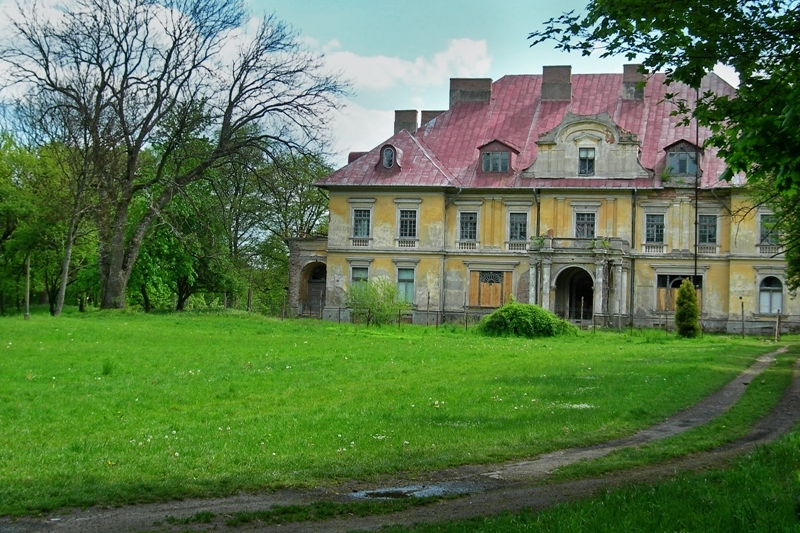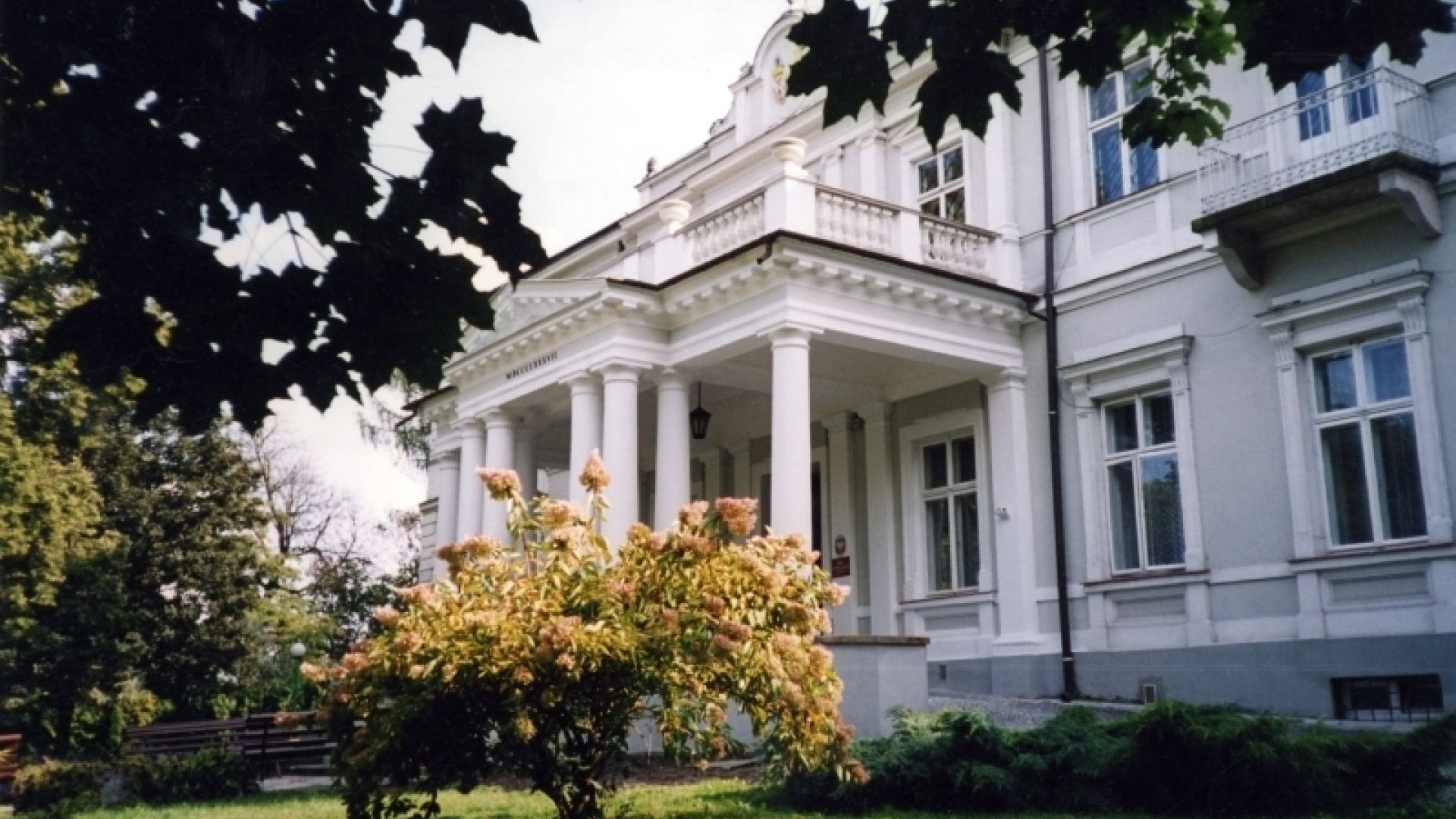The trail leads through the villages, which are linked with the writer and his family. The route covers the three districts: ostrowiecki, opatowski and starachowicki, leading mostly through the asphalt roads with a few off-road sections. Due to the length of the route, we divide it into 2 - or 3-day episodes.
Course: Jakubowice – Przybysławice – Jasice – Mikułowice – Ćmielów – Krzczonowice – Trębanów – Małoszyce – Grocholice – Bodzechów – Wólka Bodzechowska – Ostrowiec Św. – Świrna – Myków – Bukowice – Chocimów – Prawęcin – Doły Biskupie – Gębice – Krynki – Brody – Bór Kunowski – Kolonia Miłkowska – Sarnówek – Dąbrówka – Górka – Wólka Bałtowska – Bałtów – Petkowice – Wólka Pętkowska – Potoczek – Tarłów – Lasocin – Czyżów Szlachecki – Jakubowice (164 km)
Lenght: 164 km
Colour: green
Difficulty: intermediate
Jakubowice – remains of Gombrowicz family who came here from Lithuania. The manor house was storey and had ten rooms, and was surrounded by a garden and pond. After the death of Onufry Gombrowicz and his wife, the property was sold and the mansion demolished. Until this day there is no trace of the whole building but the place is marked with information.
Przybysławice – at the local cemetery, there are apartments of Gombrowicz family: grandparents Antonina Gombrowiczowa and Onufry Gombrowicz and his father John, Onufry, and the oldest of the brothers - Janusz. The grandparents" grave is in the bag of earth taken from the 1868 Remigołach cemetery in Lithuania.
 photo Municipal Office in Ćmielów
photo Municipal Office in Ćmielów Ćmielów - The little town of is located some 10 km east from Ostrowiec Świętokrzyski, on the boundary of the Iłżeckie Foothills and the Sandomierz Plateau. It sits on the Kamienna River with a tributary of River Przepaść. Ćmielów is famous for the production of the highest quality porcelain. The Porcelain Factory AS Ćmielów produces porcelain ware with the use of original models and moulds that survived together with the worldwide known traditions of the Ćmielów porcelain products. A logo of Ćmielów Exclusive is now found on the newest products of the Ćmielów factory: porcelain jewelery items. They are all hand-made and hand-decorated. The Live Museum of Porcelain was established on the factory premises in 2005. This unique institution not only displays the factory products, but also let visitors participate in the process of production as well as offer them a chance of making a finished items themselves.
Małoszyce – in 1887, the town passed into the hands of Jan Gombrowicz, who settled here after his marriage with Antonina Kotkowska. In Maloszyce, 4 August 1904, Witold Gombrowicz came into the world. Then the family moved to Warsaw, but he was staying in a small Maloszyce in the summer, which has been extensively described in the "Diary". After the death of his father, the property was sold and the mansion demolished. Today, one can see remaining assumptions of the two stone pillars and fragments of old fence of the park.
Grocholice Wszechświęte – here is a Gothic church from 1462. Built of stone blocks, the temple was plastered. Inside one can admire baptismal font from 1777, at which Witold Gombrowicz was baptized. The local parish book shows chronological record of the writer. The temple is described in Pornography.
Bodzechów – by Jacek Malachowski plan, the owner of Bodzechowskie property, in the 19.th century, these

areas had created a string of factories of iron from a blast furnace in Denków and fryszerki in Bodzechow and Borownia. Received in 1841 the furnace and forge frequently changed owners, and finally found their way into the hands of Ignacy Kotkowski (Witold Gombrowicz"s grandfather), who after 22 years of the lease became the owner of the whole complex of economic growth: iron factories, mines, forests, meadows and a large (9.5 thousand. acres) of landed estates. Currently, at Fabryczna Street in the former concierge of the building, there is a museum by Witold Gombrowicz, which is devoted to the history of the village, and the establishment of Gombrowicz and Kotkowski families. Worth a visit is also 17th-century timber church. Next to church, there is a timber belfry, stony and 19th-century cross and a statue of the Holy Virgin Mary.
Ostrowiec Świętokrzyski - the town of Ostrowiec Świętokrzyski ranks second in the Świętokrzyskie voivodeship. It borders on a large expanse of the Iłżycka Forest in the north and on the uplandish territory of the Opatów region in the south. In its 400-year-old history tradition intermingles with modernity. The historical monuments in Ostrowiec Świętokrzyski range from sacral buildings, sites connected with wartime dramatic events, to industrial heritage constructions and unique installations of the old ironworks. The Baroque church of St Stanisław the Bishop from the late 16th century is also worth a visit. Erected in the Denków quarter in 1581, it was founded by Stanisław and Kaliksta Michowski. The wooden church was dismantled in 1691 and a new brick church in Baroque style was built on the Latin cross pattern. The late-Baroque high alter contains a picture of the Holy Virgin Mary with Child from the turn of the 17th century as well as pictures featuring St Barbara and St Stanisław. In the same quarter of Denków is located a cemetery with neoclassical chapel of the Kotkowski family. Noteworthy monuments of architecture include the building of the Polish Post from the 1920s, a bit neglected building of the railway station raised in the 1880s, and city residences from the turn of the 19th century (ul. Siennieńska 14 and 37, ul. Wardyńskiego 26). In the south-western quarter of the city Częstocice stands an interesting palace of the Wielopolski family (late 19th c.) surrounded by a old park. It now houses the Historical and Archaeological Museum. Worth a visit is also the post-industrial area of the Old Ironworks as well as the former sugar factory of Częstocice, workers lodgings in the lower town, and the wooden factory church of the Holy Heart of Jesus erected in the Zakopane style in the years 1931-32. The church is located on the regional itinerary of the Timber Architecture Trail.
Chocimów – palace of 1868., now the headquarters of the school
Doły Biskupie – near the village there is a settlement industries "Witulin" founded by Ignacy Kotkowski - grandfather of Witold Gombrowicz. After his death, the lands were inherited Witold"s parents. John Gombrowicz decided to put a factory here. Development of the plant has stopped because of Second World War. Today, the picturesque scenery of the old industrial plant is used during the annual "Picnic of Gombrowicz."
Krynki – there is a Baroque church built in 1727, the chapel, which now has a beautiful picture of the Virgin Mary. Worth to see is the larch gate with two bell towers from 1779 and chapel with a statue of St. Stanisław.
Brody – in 1840 a stone dam was built in the classical style. To this day it has survived in excellent condition architecture. Exceptional stones and beautifully decorated vaulted arches show the splendor of the object. Another attraction of the village is the lake. The extensive water body with an area of 260 ha. And approximately 4 km long is a tourist center with a rich database of accommodation and catering facilities.
 photo M. Słowik
photo M. Słowik Bałtów - millions years ago dinosaurs roamed through the Kamienna River valley and left there their well-visible trail on the lime bedrock. The JuraPark Bałtów was set up nearby and it attracts lots of tourists every year. Touring the park is like traveling throughout our planet"s history from the Cambrian period till the present times. Reconstructed dinosaurs and other animal groups are the greatest attraction of the park. Worth to see the Stary Młyn (Old Mill) powered by water and still functioning. All elements of the mill equipment are in perfect operational state. An old miller who knows all secrets of the facility takes visitors around. The neoclassical palace (119th c.) of the Drucki-Lubecki family is surrounded by a park arranged in the 18th century and containing many old trees recognized as nature monuments. Prince Aleksander Drucki-Lubecki lived in the palace before WWII. The list of historical monuments in Bałtów can be supplemented by a wooden chapel of Saint Jan Nepomucen (19th c.) and a cemetery (19th c.) with a mausoleum of the Drucki-Lubecki princely family.
Potoczek – the town was frequently visited by sickly Witold Gombrowicz. The village was a property of the oldest of the sons of Jan Ignacy Gombrowicz – Janusz. The place is immortalized in the "Memoirs" and "Diary". To this day, survived well , an outline of the foundations of the cellar, and the remains of park.
Tarłów – one should notice 17th-century church. Noteworthy is the facade with two towers, between which bas-relief depicting the Trinity is surrounded by statues of St. Stanislaw and Wojciech. The interior impresses with stucco decorations, reliefs and "wheel of death" which is situated in the dome. On the left side of the chancel, the collator bench was situated, where the Gombrowicz family from Potoczek was sitting during the Masses.
Czyżów Szlachecki - the biggest attraction of the village is the 18-century Baroque palace. The two-storied residence impresses with front porches decorated with scenes of mythology. Both the palace and court buildings have been adapted into a hotel. Next monument is the gothic church, which was rebuilt in the 18th century, where one can admire the Baroque furnishings. In the nearby reserve, "Zielonka” more than 100-year-old trees and deep, loess gullies are protected.
More information: www.sejmik.kielce.pl
